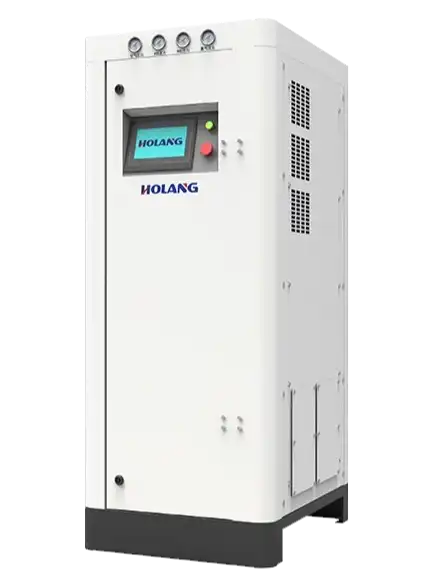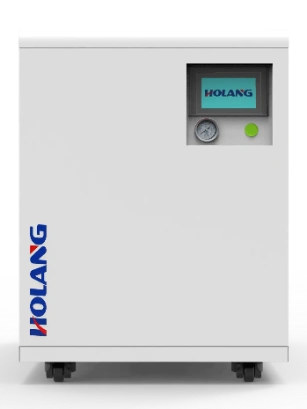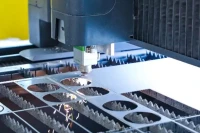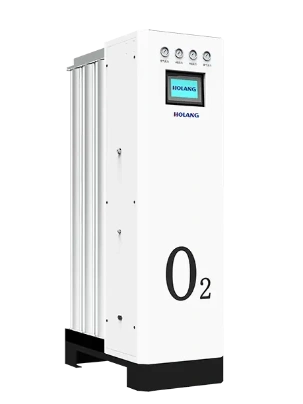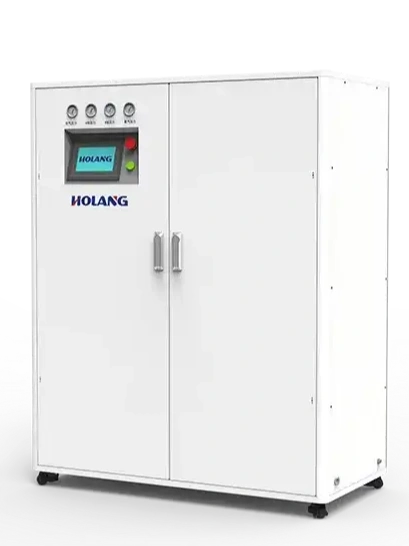Every laser cutting line depends on more than a laser source. Behind every clean, bright, and smooth edge, there is one invisible factor that makes it possible—nitrogen.
Without stable nitrogen pressure and enough flow, even the most advanced fiber laser will struggle: edges turn yellow, burrs appear, and cutting speed drops.
That is why more manufacturers are switching from liquid nitrogen delivery to on-site nitrogen generators. With a nitrogen generator, you can produce the required nitrogen directly inside your factory, continuously and safely, without depending on external supply or refill schedules.
This article explains how to size and configure a nitrogen generator for laser cutting. We’ll look at real engineering values, system design principles, and practical tips that help you achieve stable gas pressure, consistent quality, and lower running cost.
1. The Role of Nitrogen in Laser Cutting
Nitrogen is not just a cutting gas—it’s a key part of the process. It protects the molten zone from oxidation, blows away molten metal, and cools the workpiece. The cleaner and steadier the nitrogen flow, the better the cutting result.
If the nitrogen pressure drops, oxygen enters the melt zone, and the cut edge oxidizes instantly. If the flow is insufficient, molten metal remains inside the kerf, leaving rough edges or burrs. In short, the laser provides heat, nitrogen ensures precision.
2. How Much Nitrogen Do You Need?
Every laser power level has its own gas demand. The higher the laser power and the thicker the material, the more nitrogen flow and pressure are required.
| Laser Power | Typical Thickness | Recommended Pressure | Instant Flow Rate |
|---|---|---|---|
| 1–2 kW | ≤3 mm | 10–12 bar | 200–300 L/min |
| 3–6 kW | 3–8 mm | 15–18 bar | 400–800 L/min |
| 8–12 kW | 8–12 mm | 20–25 bar | 1000–1500 L/min |
| ≥15 kW | ≥12 mm | 25–30 bar | ≥2000 L/min |
These values come from real factory data, not from theory. When you design the system, always calculate the peak flow, not the average, and add at least 30% margin.
Example:
A 6 kW laser cutting 8 mm stainless steel usually needs 18 bar and 800 L/min nitrogen. A nitrogen generator rated for 1 Nm³/min with a 500 L high-pressure tank can meet this demand easily.
3. Components of an On-site Nitrogen Generation System
A nitrogen generator is part of a complete gas system. Each section has to be correctly sized to keep the pressure stable and the purity within target.
Air Compressor → Filtration & Drying → PSA Nitrogen Generator → Low-pressure Tank → Nitrogen Booster → High-pressure Tank → Pipeline → Cutting Nozzle
Air Compressor:
The compressor is your air source. If the air contains moisture or oil, the PSA unit will lose efficiency and purity will drop. Use a reliable air dryer and filters. Keep dew point below –40°C and oil content below 0.01 mg/m³.
PSA Nitrogen Generator:
A PSA (Pressure Swing Adsorption) system separates oxygen from air using carbon molecular sieves. It delivers nitrogen continuously, with adjustable purity and flow.
For laser cutting, 99.9% purity is enough. Higher purity increases energy consumption without improving cutting quality.
Nitrogen Booster:
The nitrogen generator normally produces gas at 6–8 bar, while the cutting process may need up to 25–30 bar. The booster raises the pressure to the required level. Choose a booster that can handle full flow at maximum pressure without running at full load all the time.
Storage Tanks:
Two types of tanks work together:
-
Low-pressure tank: smooths PSA cycles and keeps constant outlet flow.
-
High-pressure tank: stabilizes pressure during instant flow peaks.
A good rule: design for at least 20 seconds of buffer time. For example, with 1000 L/min peak flow, a 500 L high-pressure tank works well.
Pipeline:
Use stainless steel pipes with a diameter large enough to limit pressure drop. Keep velocity under 15 m/s and avoid too many elbows or quick couplings. The main line should be DN20–DN25 (¾–1 inch) for most medium-size systems.
4. Typical System Configurations
Example A: Single 6 kW Laser Cutter:
-
Nitrogen purity: 99.9%
-
Nozzle pressure: 18 bar
-
Flow: 800 L/min
Suggested setup:
-
PSA generator: 60–70 Nm³/h @99.9%
-
Low-pressure tank: 500–1000 L
-
Booster: 1.2 Nm³/min @25–30 bar
-
High-pressure tank: 500–800 L
-
Stainless piping DN20 with end-line filter
Example B: Two 12 kW Lasers Running Together:
-
Total flow: ~2000 L/min
-
Required pressure: 25 bar
Suggested setup:
-
PSA generator: 140 Nm³/h (or 2 × 70 Nm³/h)
-
Low-pressure tank: 1000–2000 L
-
Booster: 2.5 Nm³/min @30 bar
-
High-pressure tank: 1500–2000 L
-
Main pipeline: DN25, branches DN20
-
Monitoring: pressure, flow, purity, dew point
With this configuration, both lasers can cut 10–12 mm stainless steel continuously at stable 22–25 bar pressure.
5. Benefits of On-site Nitrogen Generation
Liquid nitrogen or cylinder supply looks convenient at first, but long-term costs and risks are high. Typical issues include frequent refilling, transport delays, pressure fluctuations, and gas loss through vaporization.
A nitrogen generator offers several clear advantages:
-
Continuous supply: nitrogen produced as needed, 24/7 operation.
-
Stable pressure: no refill interruptions or tank changeovers.
-
Lower cost: 40–60% cheaper per cubic meter compared with delivered liquid nitrogen.
-
Higher safety: no cryogenic handling or high-pressure cylinders.
-
Sustainability: reduced CO₂ footprint and logistics.
For factories consuming more than 500,000 Nm³ nitrogen per year, the payback period for an on-site generator is typically under three years.
6. Frequent Design Mistakes
1. Focusing only on purity
Most laser applications don’t need 99.999% nitrogen. What matters most is pressure stability at the nozzle, not laboratory-grade purity.
2. Undersized storage
A small tank causes constant pressure fluctuation. Design with at least 20 seconds of gas buffering under full load.
3. Poor piping design
Every 90° elbow or small connector causes a pressure drop. Use smooth bends and large pipe diameters.
4. Ignoring air quality
Contaminated air damages PSA beds. Maintain filters and dryers regularly.
5. No real-time monitoring
Without sensors for purity, dew point, and pressure, you can’t detect problems until it’s too late. Install simple monitoring—it saves time and scrap.
7. Comparing Liquid Nitrogen and Nitrogen Generators
| Aspect | Liquid Nitrogen | On-site Nitrogen Generator |
|---|---|---|
| Supply Method | Delivery & storage | Continuous production |
| Initial Cost | Low | Moderate (one-time) |
| Running Cost | High (rental + transport) | Low (electric + maintenance) |
| Pressure Stability | Variable | Stable |
| Safety | Requires cryogenic handling | No liquid storage |
| Payback Period | — | 2–3 years typical |
As gas demand grows, the difference becomes more significant. On-site generation turns a variable expense into a predictable, controllable operation cost.
8. Quick Engineering Checklist
Before you start production, check these key points:
✅ Nitrogen pressure at nozzle ≥ 20 bar
✅ Purity ≥ 99.9%
✅ Dew point ≤ –40°C
✅ Pressure drop from generator to nozzle ≤ 1 bar
✅ High-pressure tank can buffer ≥ 20 seconds at peak flow
✅ Multiple lasers can cut simultaneously without pressure loss
And remember:
Do’s
-
Design for the highest cutting condition, not average use.
-
Include both low- and high-pressure tanks.
-
Add online monitoring and easy maintenance access.
Don’ts
-
Don’t over-specify purity.
-
Don’t skip air filtration.
-
Don’t reduce pipe size to save cost.
9. Key Takeaways
Laser cutting quality depends as much on nitrogen stability as on laser power. A properly sized nitrogen generator system guarantees consistent pressure, smoother cuts, and predictable costs.
If you plan a new production line or upgrade, design your gas system together with your laser equipment—not afterward. An integrated plan avoids pressure loss, wasted energy, and future capacity limits.
When nitrogen is steady, the entire process becomes smoother, faster, and more profitable. That’s why more manufacturers now see nitrogen generation not as a utility, but as part of their core production system.

